EPISODE 127 -- A ROGUE ONE NEWSLETTER: THE NIGHTMARE SCENARIO

POP CULTURE SPIRIT WOW
At long last, here we are... “Rogue One: A Star Wars Story”. Or, as you might soon entitle it, “The Newsletter Longer than Its Movie.”
I have a lot to say about “Rogue One”. Actually, way more than I thought I did. Hopefully it’s worth your time. It’s the last episode of what I’ve been calling “Season 1” of this newsletter, so if it helps, think of it as the double-sized season finale. (And hey, unlike most season finales, it doesn’t end in anyone dying!
Oh wait. Shoot. Probably more accurate to say it ends in everyone dying. Sorry about that.)
Oh, by the way – Spoilers.
I’ve given each section a title in case you’re interested in any one thing more than the other. And if you’re not interested in the “Star Wars” universe, there’s always the links at the end. Enjoy.
++I HAVE A BAD FEELING ABOUT THIS REBELLION BUILT ON HOPE TRAP++ I know I’ve been saying for what seems like months now that I was desperate to talk about “Rogue One”, I just didn’t want to ruin it. But as I’ve started writing this I think I’ve also been struggling with how to talk about the film. In a number of significant ways, it is not a “Star Wars” story.
For instance, it has little of the spiritual about it. What’s there is super interesting, as I’ll get into below. But in comparison to every other “Star Wars” film it’s very limited. The film leans on the concept of hope instead as its main source of meaning or value; not a bad idea (says the Catholic priest), and in fact one with a lot of resonance for our world today (says the watcher of news).
At the same time, “Rebellions are built on hope” is only a powerful statement once. Repeatedly, it’s a bit goofy. (Seriously, that phrase is like this film’s version of “I have a bad feeling about this.” I almost needed them to use it even more and in different ways to liberate it from being so earnest. Like, when Cassian and Jyn were getting shot at in the data chamber, to have Kaytoo radio in, “Rebellions might be built on hope, but laser rifles also are necessary.”)
Plus, the first trailer had that amazing, galvanizing moment when Jyn listens as all the Alliance muckey mucks list all her crimes, then responds “This is a rebellion, isn’t it? I rebel.” How does that not find a way into the movie?
Then again, almost NOTHING from the trailers were in the movie. REALLY. Not even the music.
(The book has a slightly different moment where Baze asks Jyn what she wants to do in the face of the Alliance’s refusal to attack Scarif. Chirrut says, “She wants to fight.”
And Jyn thinks to herself, “It’s all I’ve ever done. It’s the only answer I have.” Another great idea.)
++ CHARACTERS MIGHT GROW IN BROOKLYN, BUT THEY DON’T SO MUCH ON JEDHA ++ Also, I know some will disagree with this, but I found the film had little in the way of character development or even exploration. In “Catalyst”, the prequel novel to the film, bad guy Orson Krennic, AKA Man-Who-Loves-Him-Some-Clorox is a brilliant strategist who successfully plays everyone, even Grand Moff Tarkin (who insists on being called “G-Moff” and “The Tark”).
(What? Don’t believe me? Okay, maybe not “The Tark” But he does want to be called “G-Moff. And he is constantly dabbing.)
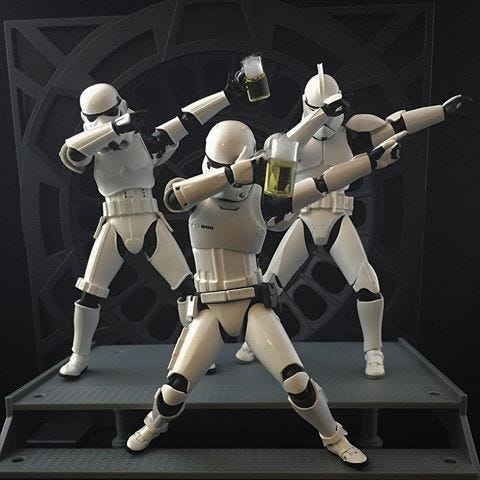
A great example of Krennic’s brilliance – he gets Galen to work on the Death Star without Galen knowing that’s what he’s doing. Galen and Jyn’s mom Lyra were both energy development scientists. Lyra is a lot of other interesting things, actually, including a devotee of the Force. (At one time the writers were supposedly thinking about making her a Jedi.) Galen, meanwhile, is a scientific genius who gets offered a job by his former-classmate Krennic running a lab tasked with researching the energy possibilities of the Kyber crystals that power light sabers. Krennic intends to use the research to power the Death Star (whose build he was secretly supervising elsewhere), but Galen doesn’t find that out until almost the very end, because Krennic is that smart.
But in the film, other than that wonderful opening scene – “Oh, look, your wife is alive again” – Krennic is relegated to the role of near-patsy, running between Tarkin and Vader with his tail always between his legs, not a plan in his brain, and reacting reacting reacting. Eh, that guy.

*sigh* He seemed so wonderfully dangerous.
You could say main character Jyn Erso changes, I guess, insofar as she has a Han Solo-like in-it-for-herself quality at the start, but that really doesn’t develop and change as much as suddenly reverse itself. She was against it all, then she’s fully on board.
Maybe that sounds unfair. But compare her journey to Luke’s halting progress towards using the Force (or even knowing what it is), or Leia’s willingness to trust others. Even better, think of Solo. Even when he’s helping out in “A New Hope”, he’s still in it for himself. He gets that whole movie to make the same change that Jyn makes in just one scene. Truly: his final turn occurs in the last major scene of the film, when he shows up out of the blue to save Luke. I can still remember seeing that for the first time and not being sure what had happened. How is Han Solo here, 7-year-old me wondered with giddy confusion. Didn’t he just leave? And when do I get to ride on the Falcon?
Of the whole cast, only Cassian really grows. At the beginning, he’s killing his allies as well as his enemies for the Rebellion. But then he can’t quite convince himself to kill Jyn’s dad, aka Death Star’s Daddy. And then he’s willing to turn on the Rebel Alliance to go with Jyn to try and make all the dirty, ugly sacrifices he’s made mean something. And then he dies doing it. Now that is a classic “Star Wars” journey.
It’s also an exciting one because it’s so different – Han Solo undoubtedly did some dark and dirty stuff before we met him. (Remember he was a drug smuggler. Also, THIS:
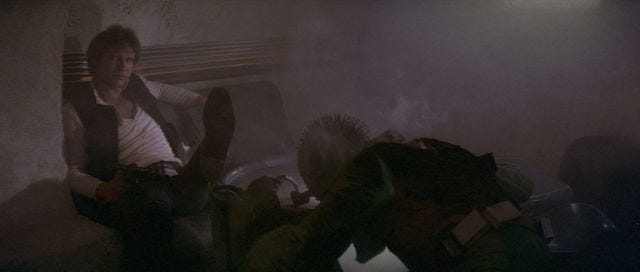
But the films never take a look at any of that, even whitewashing his straight up murder of Greedo. And by the time we actually get a glimpse into the world Han came from in “Return of the Jedi”, Lucas had morphed enough into “Hey, Animation and Care Bears!” that it has no edge. (Seriously, how is Jabba the boss of anything? He can barely lift his slug head.)
With Cassian finally we get to see a bit of this universe’s dark underbelly, and that’s a fantastic choice.
It’s interesting, too, Jyn really comes from that same world. I’ve been reading the novelization of the film, and one of the most insightful observations there is that Saw did not just raise Jyn; he trained her. She was his best fighter. Which is to say, she did some terrible things for him. In fact part of her being on her own, away from the Rebellion, has been a desire not to go down that path again.
Our first scene with adult Jyn shows her in jail, which suggests she’s no hero. But it sure would have been nice if we had seen her be a criminal (or whatever) first. See her get arrested, and learn from it not only that she’s a serious fighter – which we instead learn when she attempts to escape her rescue – but that she’s not a nice person. This is not your Grandmama’s Ewok “Star Wars”.
(Behind the scenes cool aside: There was a lot of talk before the film about its ext(p)ensive reshoots. Well, according to the film’s editors, one major part of those reshoots was adding those initial scenes of Cassian and Jyn. Apparenly the first cut of the film went right from Baby Jyn Hides in Hole to something like Jyn-Being-Confronted-By-Alliance-About-Her-Death-Star-Dad.
(Note: In the “Star Wars” universe, “Death-Star Dad” is their equivalent for “Deadbeat Dad.” Sometimes they call it “Doing an Erso”.)
(Second cool aside/third in an unnecessary series of parentheticals: Felicity Jones was actually signed to a two picture deal for “Star Wars.” Which is...strange...considering how things end.

Maybe if we don’t look it’ll just pass us by.
Now, that contract stipulation may be because perhaps in the original script she wasn’t going to die. (It would be sort of fun to have a movie that runs parallel to “A New Hope” and concerns something else. Like the conception of Rey, for example?
Enough with telling us Rey’s parents are no big deal, Daisy Ridley. THEY ARE. THEY REALLY ARE.)
But, it could also mean that Jyn is being considered for a role in the next “Star Wars Story”, Young Han Solo. Which if you think about it could be super fun. Perhaps she was in jail in the first place because of Han?
Of course, the problem then is, how long has she been in jail? Because otherwise, how could she be in Young Han Solo rather than smirky 30something Harrison Ford Han Solo.
Even so, I like the possibilities. I really do think there’s more Erso to tell.
++ THE STAR WARS RULES FOR WOMEN ++ This points to maybe my one other struggle with the film. In the ads, Felicity Jones is EVERYTHING. This film is her story and she is amazing.
But in the actual film, not only is her arc pretty weak, but a lot of her action is determined by men. She goes to the planet where it never stops raining to find her dad. She joins the rebellion because of her dad. Her big, rebellion-inspiring line “Rebellions are built on hope” *fart noise* (I’m telling you, it would have killed) is just her repeating a man. (I hate that so much.)
Somewhere in there she and Cassian start having feelings that never really fully add up. But somehow they are enough that when she has the chance to kill her dad’s nemesis, Orson Krennic, aka Mr. Clean Robes, she lets Cassian hold her back.
Actually that one moment is for me the most troubling thing in the whole film. Maybe it was part of a reshoot, I don’t know, but to me it betrays both Jyn and the rules of ”Star Wars” to have her held back like that. Women in the “Star Wars” universe do not get told what to do by men. Even if George Lucas sometimes makes them dress in ridiculous ways, they are self-actualized. Even if they’re slaves forced to dance for slugs, they’re still badass enough to refuse him though it means they get put to death. Even if Leia does get all giddy and puppy dog eyes with Han – which, notably, takes TWO MOVIES to happen -- she’s still enormously bad ass. (Everyone remembers the Slave Leia costume, but for me, this is the height of Leia cool:
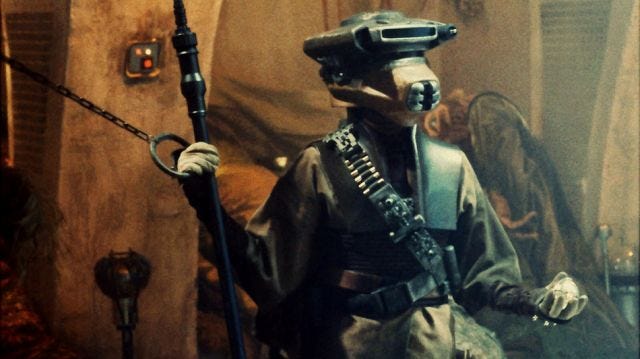
YOTO, PRINCESS. YOTO.
I’ve been doing a fair amount of criticizing so far. I actually enjoyed “Rogue One” a lot. I’ve seen it three times, will probably see it at least once more, and in fact one of the things I like about it is that somehow its script is pretty significantly flawed, and yet it remains a satisfying movie. That is not easy to accomplish, even for “Star Wars”. For instance:
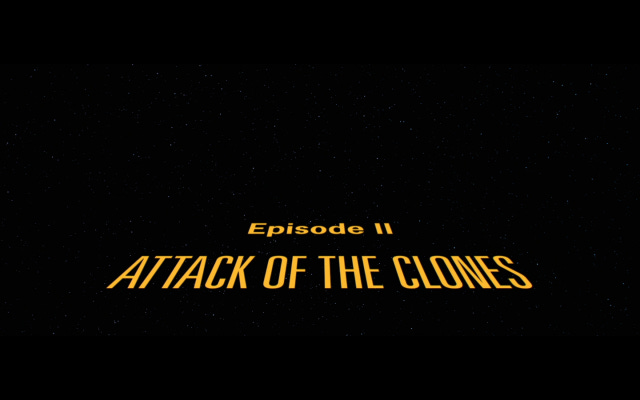
(Hey, did anyone else miss the opening crawl? (This guy did.) I get that they were trying to differentiate themselves, but I don’t know, it all felt a little sudden and jumpy and the title they finally flash for Rogue One just didn’t seem right and it that had weird marchy-martial trumpet music that was totally wrong for a movie about murderers and spies and sacrifice.)
And speaking of sacrifice...
++ WHAT REBELLIONS ARE ACTUALLY BUILT ON (HINT: IT RHYMES WITH BALDERAAN) ++ One of the things I love to do with “Star Wars” films is look for parallels. The seven main-story films have tons of riffs upon one another. How would that play out in this side film, I wondered?
And I see lots of riffing both in terms of characters and events. In some ways “Rogue One” stands as the mirror image other-book end to “A New Hope”. We get seven characters (more or less) who go through three major adventures – an escape from a planet, an attack upon a base and an impossible death trap escape from an imperial station (with the second and third reversed in ANH). And fundamentally the two films end in the very same way, with everyone risking everything against absolutely impossible odds and then finally in the craziest of ways succeeding through a combination of friendship, faith and trust.
The difference is, in “Star Wars” the main characters didn’t also lose their lives; in “Rogue One”, they did – and not just the main seven, either. You know that Admiral Ackbar’s Cousin Guy (Admiral Raddis) who leads the Alliance charge on Skarif? (God I love that guy.)
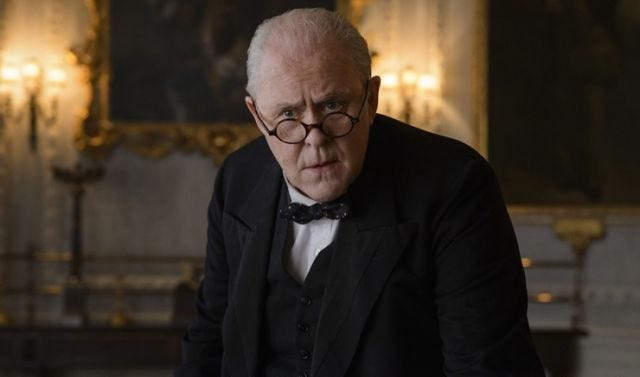
When I googled images of Admiral Raddis, this image is the fourth most popular. Which is weird not only because it has nothing to do with the film, but because the article is about how Raddis is “Rogue One”’s Winston Churchill, but then instead of actually showing us an image of Winston Churchill they’ve given us an image of John Lithgow playing him in the new Netflix show “The Queen”, though Lithgow neither looks nor sounds anything like Winston Churchill.
Ah, entertainment media. What a special snowflake you are.
Anyway, do you remember what happens to Raddis?
Yeah, me neither, because they never show it. But it’s definitely bad, as in “We don’t call your kind Calamari for nothing”, because his ship is the one that Vader comes aboard to get the plans. We see it stalled as the other ships flee; it’s the ship the Empire had concentrated its fire on towards the end. And it’s from this ship that Princess Leia and the Tantive IV blast free.
So yeah, Raddis, who in many ways saves the day for our heroes? He swims with the marinara.
And there’s also all the nameless guys on Raddis’ ship who become saber and Force choke fodder for Darth Vader’s terrible no good very bad day.
(By the way, did anyone else have to restrain themselves from shouting at the guy trying to get through the door that won’t open even as Vader is about to kill him and take back the plans? DUDE, MY GIRL AND HER BOY AND HIS ROBOT AND THEIR NINJA DANCING JEDI AND HIS LOVER/PARTNER/WHY DO WE HAVE TO DEFINE EVERYTHING AND A LOT OF OTHER PEOPLE JUST DIED TO GET THAT INFO. I KNOW YOU DON’T WANT TO DIE EITHER, BUT JESUS, MARY & JOSEPH, HAVE A LITTLE PERSPECTIVE.)
That end sequence is so interesting. It starts much like “A New Hope”, the guys racing through the white hall getting ready to be boarded; in fact I almost wondered if maybe they were replaying that opening. But then the lights go out and Vader comes in and oh my God #!% gets CRAZY. It’s the only time we have ever witnessed Full Vader. Terrifyingly spectacular. Honestly, I want a movie of THAT.
(I haven’t rewatched “A New Hope” since but I have to imagine the Ben/Vader fight is going to seem out of place now, much more Grandpas With an Ancient Grudge.)

Even the Vader moment doesn’t involve just one group of guys dying. We get the initial sequence, then the guys in the next room are also cut down, including the new guy with the data. And then it’s only the guy who takes it from that now-dead guy that makes it onto the Tantive IV and gets away.
I think there’s a massively important point to all this. In fact I think rather than just Vader fan service that sequence is a sort of coda that clarifies what this film was all about. And it’s not hope, not really – I believe milady did protest too much. It’s also certainly not mercy, which I would argue is the heart of the original trilogy.
No. The core of “Rogue One” is the necessity of sacrifice. Hope, possibility, the future – these things do not just happen. Payment must be made for them. And – unlike in the original trilogy, and much to this film’s credit – that sacrifice is not just the work of the few beautiful heroes. Everyone has to carry that burden.
In a sense, it’s appropriate that this theme comes clearest in a scene with Vader, because Anakin is the “Star Wars” character who doesn’t deal with paying the prices that reality puts before him. Rather than accept the horror and grief of his mother’s death, he murders a whole village of Sandpeople. (another group I’d love to see in a film of their own. “Tatooine: A Star Wars Story.” YES PLEASE.)
Rather than say no to Palpatine’s demand that he behead Count Dooku, Anakin gives in. Rather than just deal with the possibility that his wife may die – you know, like everyone other spouse or parent has to deal with every day of their lives -- he betrays the Jedi.
Even his physical descent into Vader could be construed as coming from an inability to accept. How many times does Obi-Wan warn him that he can’t make that jump over him? But rather than accept defeat he does it anyway, and has his legs cut off. (I know it’s ghoulish to say this, but I love that moment.)

And when does Vader finally become Anakin again? When he sacrifices himself for his son. His son, who while whiny and with bangs and an unsettling late-series interest in dressing like his dad (“What? Black is slimming.”), has been the one person willing to make the most massive of sacrifices himself, that is ignoring logic and risk and the wisdom of absolutely everyone, including his Jedi spirit guides (seriously, he straight up blew off Yoda not once but twice, and was proven right both times; what do you think the chances are that any other Jedi ever did that?), in order to save his dad.
One major difference between the original trilogy and “Rogue One” is that while characters in the trilogy make some serious sacrifices – Leia lets her home planet get blowed up, yo – those sacrifices always pay off. Okay, maybe not for the people of Alderaan, but Luke does save his dad, the Empire does fall; Han – who sacrifices his own safety for the good of the Rebellion -- does get frozen in carbonite for a while, but in the end he’s fine. With the exception of Ben halfway through “Star Wars”, not one major character dies in the whole trilogy. Think of that. Harrison Ford famously asked to get murdered in “Return of the Jedi”; personally I think they should have killed Chewbacca or maybe Lando. Someone that would really affect us.
(That’s one of the things that makes “Force Awakens” so interesting. Han getting killed by his son, and near the end of the film rather than with quite a bit of story left to go, gives the movie a sense of cost that is new to the ongoing series. I suspect Eps VIII and IX are going to continue to play with themes of love and mercy, but it’ll be interesting to watch. Sacrifice could very well come into it.)
++ LUKES AND LEIAS++ Did you spend any time during the film thinking about which character is which – i.e. “Who’s the Leia? Who’s the Luke?” I know I have.
It’s unavoidable, really. I mean the film is about a group of seven characters coming together to save the universe, just like the original. But it can obscure important things, too. In a sense the movie has two Bens, rather than one, and no Artoo, and also Jyn might be strong like Leia, she’s a natural leader, and she’s an orphan raised by someone else, but she’s got differences, too. She saw her mother killed, for instance. As far as she knew her dad was working for the Empire. Her adopted father was a soldier (and eventually an extremist) who taught her how to do horrible things. He is no, well...
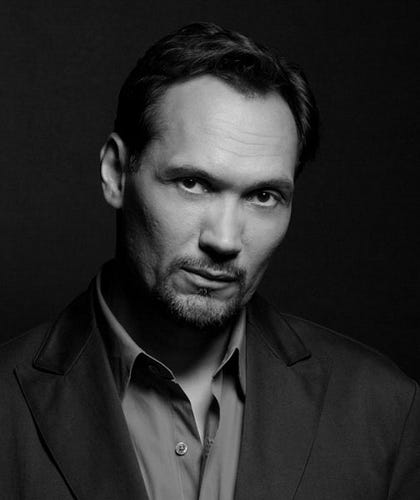
Bottom line, Jyn is both dangerous and damaged in ways that Leia isn’t.
Cassian is I think probably closer to Han in background – he even dresses like him. But he’s got none of Han’s charm or sense of humor. We never do hear what happened to his family as a child, but the results has been a whole life of urgency and danger. Whatever Han’s childhood was like, he turned out pretty well adjusted. Cassian is much more the refugee kid who grew up in a warzone.
Then there’s K-2S0 (or Kaytoo), the film’s break out star, in large part because actor Alan Tudyk was given tons of freedom to improvise. Seriously, he did such a great job, I’d be shocked if we don’t see another Kaytoo unit down the track. (It’s great to be a model of droid.)
Also, how great is it that they found a way to keep the idea of the Empire using robots as soldiers – which makes tons of sense -- but adapted it in such a way that finally we get a robot that works – i.e. that is freaking scary and dangerous, and not some sort of comic strip version of itself).
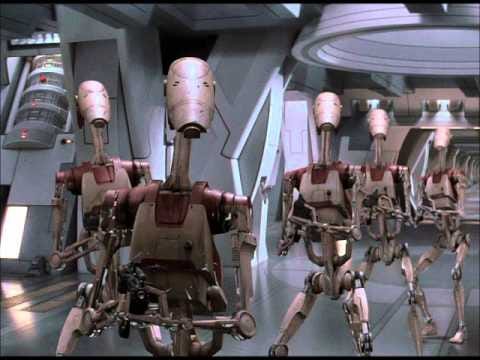
You are an embarrassment. And the clear source of iPhone spellchecks.
In terms of links to “Star Wars”, Kaytoo takes a lot from C-3P0. He’s humanoid in form, he’s articulate; while I wouldn’t call Threepio sarcastic per se, that quality of Kaytoo does seem like a natural and welcome progression.
Actually, come to think of it, maybe that’s a bit of a pull from Artoo. Kaytoo definitely has other Artoo traits – he is repeatedly the data-gatherer for his team, even uses a nozzle like Artoo’s to get data from one of his own kind (a wonderfully weird and creepy scene). He’s also the copilot of their ships, just like Artoo.
And as much Artoo has a child-like quality, he is also regularly sarcastic. (There’s that great explosive sound he makes when he’s disgusted with Threepio.)
So, K-2S0 – maybe Threepio + Artoo, but designed to torture?
++ DIVERSITY HIGHER ++ Then there’s Chirrut Îmwe, our Dancing Tiger Jedi. Kaytoo might be funny, but Chirrut is definitely my favorite character, not only because of his fantastic abilities but because he has that spiritual take on things, “I am one with the Force and the Force is with me”, which is basically the “Star Wars” version of this:

Long time readers, you know you missed this.
His take is consistent with the Jedi way – Episodes I-III in particular talk a lot about being in the moment, being present; in fact, I think younger Obi-Wan’s special talent, the unique way he participates in the Force, is through his ability to improvise, to respond creatively to whatever is in front of him.
But the other “Star Wars” films never really focus on that gift of being present. Most of the time what makes a Jedi a Jedi is their hyperfast reflexes. In Episode I Qui-Gon reveals that’s actually a function of their ability to anticipate the future, but like most things Qui-Gon says, that #!%! ain’t right. When Luke hits the target at the end of “A New Hope” (spoilers), it’s not because he was able to anticipate something. It’s because he was in the moment.
In other words, Shut up, Qui-Gon Jinn. Shut up.

None of us do, Ani. He crazy. Like, Mr. Brady crazy.
With Chirrut we get an embodiment of that combination of presence and trust that is the heart of the “Star Wars” universe’s spirituality. And he’s not even a Jedi. (Some have argued, he probably is, it’s just that there are no Jedi any more. But that’s not correct. Chirrit and his partner Baze Malbus (aka Semi-Shaved Chewbacca) are just “Guardians of the Whills”, people who have dedicated their lives to taking care of the Jedi Temple that used to exist on Jedha.
Now, the expanded Star Wars universe has long talked about people who are “force sensitive” – they have some connection to the Force, just not as much as Jedi. And that might be one way of thinking about Chirrut, though that idea has not appeared in any of the movies. But Baze doesn’t show any such sensitivity, and yet he, too, at the end of the film, takes up Chirrut’s mantra.
I have to say I really like this. It suggests that not only does the Force flow through all of us, as we hear over and over, but that we are each able to be connected to it in some way. That it’s not just for Jedi and Sith, but all of us in some way. Which, even if that doesn’t mean we can all make doors open with our fingers, is still a radical democraticization of the “Star Wars” spirituality.
It might have been a bit more powerful if Baze had lived longer or done something a bit more incredible after taking the mantle on. (Like, if he had closed his eyes from then on, paralleling not just Chirrut but Luke.) But I think we’re meant to understand at the least that connecting with the Force allowed him to proceed forward not in anger or grief, but dispassionately and with trust.
For me, Baze really is kind of this film’s Chewbacca, and that classic Joseph Campbell archetype of the hero’s animal companion; he barely speaks, he’s the deadliest of anyone in the company. He's always got Chirrup's back, and he’s as loyal as they come.
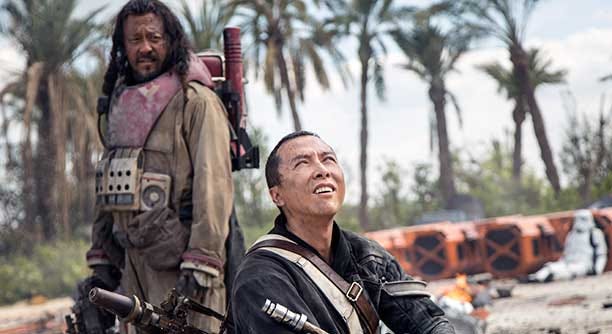
But these guys are probably more than friends, no? That scene at the end between the two of them is so poignant. Baze shows a level of emotion that goes beyond simple friendship; and so is Chirrut’s response, not just taking his hand but reassuring him that Baze will always be able to find him.
The meaning of all that is not obvious or for certain. But even that seems to fit the interpretation. Two characters who have been in a long-term relationship don’t necessarily have that much to make things overt or certain; they already know how they feel about each other. No, that’s more what storytellers do to shine a light, #ICYMI style.
Some have criticized “Rogue One” for being too interested in diversity. (Some day that sentence is going to read even more ridiculous than it does today.) But for me the Chirrut/Baze relationship shows exactly the level of the creators’ subltety. Our race, gender, orientation are all important aspects of ourselves, but most people in real life don’t spend all their day to day life talking about those things (other than when being attacked for being those things). They just are what they are.
And that’s how things go in “Star Wars.” We never get a “You’re just a girl” moment, or have one of the many non-white characters speak in an “I am not Western European” accent. They are who they are. And that’s the very same for Chirrut and Baze.
Also, there’s something about a Jedi and a Wookie in a relationship that just seems so out of the box that it has to be right, don’t you think?
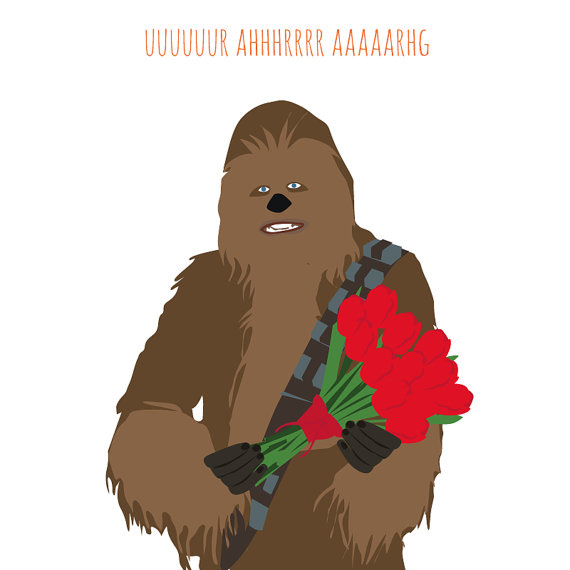
++ BECAUSE EVERYTHING IN STAR WARS COMES DOWN TO YOUR DAD ++
I said there are two Bens in the film. Chirrut is one. He’s the most-Jedi like of anybody. And his words to Baze at the end of the film capture what Ben intimates before he lets Vader kill him. Death is not death. He lives on in the Force.
The other Ben is Jyn’s dad Galen. Just like Ben with Luke, Galen’s death is the moment that puts Jyn into motion in a big way. And the hologram scene in “Rogue One” is literally a mirror image of the Ben/Leia scene. Both holograms are about the Death Star’s weak spot; both are meant to recruit help. But rather than receiving the hologram, as Ben does from the now-adult child of Anakin that he helped to hide), real father Galen is the one providing it.
While for me the “Rogue One” version goes on way too long – in part because what comes before it, that reunion scene between Saw and Jyn, is long and weirdly stilted* -- I love the fact that the filmmakers thought to riff on “A New Hope” in this way. It’s right there in your face, and yet at the same time, unlike say the Death Planet of “Force Awkens” it doesn’t feel derivative.
*Ben Mendelsohn, who plays Orson Krennic, told Collider that many scenes in “Rogue One” were shot multiple times with different sorts of emphases to the acting. Those differences are so significant, in fact, he said if played they would result in dramatically different versions of the film. (The “Star Wars” team has spent the last couple weeks walking that back, but good luck.)
It’s not at all unusual that a different cut of the movie would be pretty different. But the amount of variations being done from the get go does sound strange, as though the filmmakers weren’t quite sure as they went along what story they wanted to tell. And some scenes also play really strange. Like the strangely disconnected Saw/Jyn scene: if you plan to see the film again, watch it closely. Though it is meant to be this emotionally fraught reunion, Jyn reuniting with the father-figure who saved her and then inexplicably abandoned her – seriously, people, this girl has been through SOME LIFE – the two characters never appear onscreen together until the hologram. In fact, I’m not sure the actors even shot the scene together. The shots of Saw with Jyn in the frame are so careful only to include the back of her head, it could very well be a body double for Felicity Jones standing there.
That’s weird. Like “The Good Wife” Kalinda and Juliana Marguiles at the bar saying goodbye in separate shots weird. It’s also clear from the trailers that they definitely reshot that scene. (And also, that the original versions had much more interesting conversation in them.) I would just about bet money that in fact Forest Whitaker wasn’t able to make the reshoots at the same time Felicity Jones could, and consequently they shot separately, and got that cold awkward mess of a result.
The Krennic scenes are similar, in that he’s often playing against The Digi-Tarkin, aka “How Green Does My Grand Moff’s Uncanny Valley Grow”, and that same back and forth cutting happens, though in his case with other people standing by (and with the animators having the ability to draw in Tarkin’s face at will).
(Funny thing: One of my nieces had no idea that Tarkin was a digital creation. My dad wasn’t sure if Digi-Leia was in fact animation or just youth-enized (boom) a la oh-so-smooth-and-pretty Robert Downey, Jr. in “Captain America: Civil War”. Personally, I found the likenesses so distracting the first time I actually could not hear what they were saying. Which is really the definition of the uncanny valley.* Surprisingly, on second (and third) viewing, I had almost no problem with any of it. In fact, I kind of ended up liking having Cushing’s Tarkin in the film. And though God I hope they have enough sense (and respect) not to try to digitally recreate Carrie Fisher for Episode IX, the fact that DigiLeia gets the last word in “Rogue One” and that word is “Hope” was super meaningful.
*For those who have never heard of the uncanny valley, it’s a term related to realism in animation. There’s something about the way we’re built that if an animated image is too realistic, it instinctively creeps us out. Think this (and everything else) from “Polar Express”:

If you look away you’ll find you’re able to stop screaming.
The “valley” is that area on the spectrum from ultra-non-realistic to ultra-realistic where we get creeped out. Here it is as a chart.
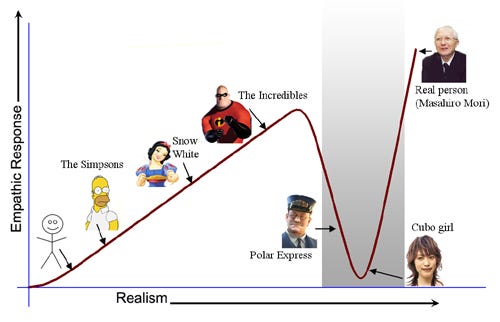
Calling it “uncanny” is being nice. It really should be the “Oh My God What is That” valley.)
++ALMOST THERE++ I really am, I promise. (So tired.)
I mentioned Saw Gerrera before, and if we’re talking parallels I would be remiss if I didn’t mention him. When you saw Saw (...See Saw? See Saw See Jyn? See Saw Run?) breath into that mask when he meets the pilot, what did you think?
You thought drugs, didn’t you? What are you, living in a big city on a coast? The world is not all about drugs, people.
(I totally thought he was taking nitrus and he was going to do something crazy. That scene was really poorly executed.)
Now it turns out Saw is in really bad shape and that’s just oxygen. (Sure it is, Saw. Sure it is.) He’s also got the metal foot and who knows what else. He tells Jyn, “There’s not much left of me.” Later, though he truly was her father most of her life, he insists that she leave him.
Does any of this sound familiar? Maybe his labored breathing?
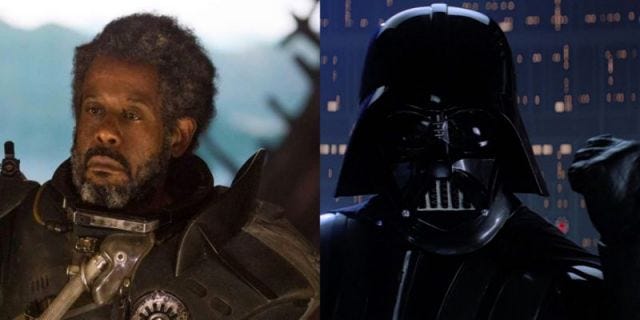
I know, it's a little off. I mean, they don't seem like equals. Darth Vader is the big bad. Saw is kind of a good guy. I mean, yes, he’s all up for telling his men to kill whoever to get the villains, but...
Okay, yeah, so maybe not such a good guy anymore.
And that’s the connection I think the film is trying to make – if Vader represents evil on the ultra-right, Saw is his equal and opposite on the ultra-left, fighting to overthrow the rebellion by any means necessary, and suffering as a result the same complete loss of his humanity. In a sense it's the natural extension of the whole Cassian/assassins and spies bunch. Rebellion alone doesn't make you good or wash away your sin. Both sides have the capacity to go down the dark rabbit hole.
It’s a fine idea, but I’ll be honest, I think all of that was kind of vague and confusing. In fact, if I could give Saw Gerrera a middle name it would actually be “vague and confusing”. He’s so important to Jyn’s story, he’s played by an Academy Award-winning actor, but then we see him almost not at all, his behavior is constantly strange – he tortures the pilot and then doesn’t seem to care when the pilot turns out to be true; he welcomes Jyn, then gets paranoid she’s a plant, then immediately shows her the hologram – huh?; his failing body situation is not clear – did it make sense to you why he wouldn’t make a run for it? I did not get it.
++USE THE FORCE, BODHI?++ The main figure missing in this whole conversation of parallels, of course, is Luke. There is no real Luke Skywalker character in “Rogue One”. And maybe that sort of fits, because this is not a world of innocence or idealism, and that’s what Luke brings in spades.
And if the future is, as the characters keep insisting, a universe built on hope, it’s not the kind of “anything is possible” wonder-hope of Luke, and more the “hope against hope” that oppressed peoples have been crying out from for the whole history of the world.
There is a pilot in the film, though, Bodhi Rook, who betrays the Empire to bring Saw the information from Galen, who has his mind licked (ugh) clean by a handsy Hutt (ugh ew yeesh) and helps save the day a bunch of times. And before he was ever a Jedi or Vader’s kid or Island Gandalf, Luke was a really good pilot.
And come to think of it, of all the characters Bodhi does seem the most innocent, doesn’t he? He’s undoubtedly seen some really bad stuff, but it doesn’t really seem like he’s done anything terrible himself. In fact, I’m not sure he even kills anyone in the whole movie.
He’s also kind of needy. Not quite in the same way as Luke, but still...

I'm good enough, I'm smart enough, and Goshdarnit a slug recently licked out my brain...
(I’m trying, people.)
Actually, there is one super cool Luke moment that I only noticed on the third viewing. (See, Society of Jesus that gives me money? I DID need to see “Rogue One” three times!)
So while Not-Luke, Damaged-Leia, Murder-Han and company are saving the day below, up in space above Scarif we get that fantastic X-Wing (and others) vs. TIE fight. (Thank you, creators, for that. More well-choreographed space fights, always and please!)
And the fight has that super cool detail of cutting in old footage of Luke’s Red Squadron leader. It makes sense – if he was at the Death Star, he’d be up there at the Battle of Scarif.
But that’s not the cool part. There’s one moment in the battle where an X-Wing pilot gets shot down. And just before it happens, Red Leader yells out something about “Red Five, watch out.” It’s too late, and Red Five dies.
Then a lot of other people die. Then Kaytoo’s circuits get fried. Then Chirrut dies. Then Bodhi dies. Then Baze dies. Then Krennic dies. Then everyone else on the base dies – some along a very romantic stretch of otherwise blood and oil-filled beach.
Then a ship runs into Darth Vader’s star destroyer, and he dies. Then the Calamari dies (but oh God is he delicious!). Then the guy who won’t give up the plans because he was supposed to retire today dies. Then the guy he gives the plans to trips and dies (nice job, ace). Then other people die.
And then, I don’t know, a day later? the pilot of Leia’s ship dies, along with a lot of others. Then a bunch of Jawas die. Then Luke’s aunt and uncle die. Then Walrusman dies and his drunk pig-nose friend loses an arm. (You MUST read this short bio of the friend. It is INSANE.)
Then a lot of stormtroopers die, a couple times. Then Ben dies (or dissolves or something) and Darth Vader is like, Whuh? And Luke is all...
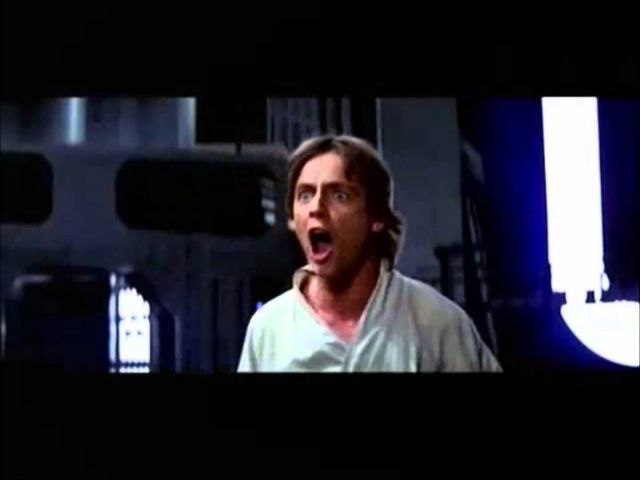
Then a bunch of TIE fighter pilots die and Luke ends up on Yavin Four in time for the big final battle with the Death Star. But if he’s going to fight he’s going to need a call sign, amirite? And Rogue One is already taken, plus nobody knows it because that movie isn’t for forty years so they give him...Red Five.
You already knew that, didn’t you? *sigh* I’m always so excited when I discover an Easter egg on my own, and then it turns out I’m the only one who didn’t know it already.

++ SPEED(ER) ROUND ++
After Vader frees Krennic from the force choke (what was that scene for, anyway?), he actually makes a pun. Actually, it’s a double pun: “Be careful not to choke on your aspirations.” Seriously, writers, worst choice in the film. There is no way Sith pun.
In the book before Jyn talks the rebels into trying to steal the plans she has a Rey-like dream vision of all the significant parental figures in her life. It ends with her mother, who helps her figure out what she wants to do. It gives her a much clearer journey to that decision. It also gives her mother more of a place in her life – NOT EVERYTHING IN STAR WARS NEEDS TO BE ABOUT YOUR DAD, CREATORS! – and it allows the whole “I’m wearing a Kyber crystal, which is connected somehow to the Force and Jedi and stuff” to have a purpose, which in the film it does not.
Anyone else have trouble with the film’s score? It absolutely did not work for me. Nothing memorable.
The opening shot of the film seems on some level like it’s trying to parallel that amazing original opening of the star destroyer slowly filling the screen. It doesn’t quite work, in fact it’s not really clear what we’re looking at. But definite points for effort.
Remember that weird moment on Scarif with the two stormtroopers talking about some old model of something that’s being replaced. What was that about? One great take I read: “Rogue One” is the first “Star Wars” movie that’s actually about war. And part of that is meeting people on both sides who are then suddenly killed.
I would have watched an entire film of just the Death Star in different positions on horizons. (Favorite: Upside down.)
(I would also watch a whole movie of this.)
Cool insight stolen from someone else: we’ve always thought the “new hope” was Luke. But given how this film ends, it’s at least equally the plans to the Death Star.
And with that....

It's away!
++ LINKS ++
Ever wondered about the behind the scenes on “Saturday Night Live”? This crazy video shows how the crew transitions the stage from the opening sketch to the opening monologue in less than three minutes.
This week David Brooks in the New York Times had a really insightful article on how we should understand Donald Trump. Unlike most pieces like this, Brooks – though not a fan of Trump – actually is mostly trying to explain and understand rather than attack. And he uses something from the pop culture zeitgeist to do it, to boot. Highly recommend!
Every week the New York Times also posts its “Metropolitan Diary” which is little stories from readers about living in New York. This week had some really beautiful stories.
And if you haven’t had enough of Rogue One, first of all, What is wrong with you? Second of all, Can we be friends? Third, here’s another cool article about things that didn’t make it into the film, complete with some fantastic photos.
Thanks so much for reading this. Keep your head up. Don’t be afraid to rebel when you need to. Screw the Death Star. And people who want to cut your best lines.
See you on January 20th.

